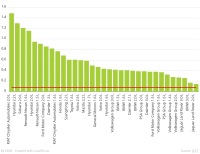
Photo from wikipedia
To investigate the emission status and predict the future trends of heavy-duty diesel passenger buses in Hainan Province, the technical level distribution, activity characteristics, and operating conditions of heavy-duty diesel… Click to show full abstract
To investigate the emission status and predict the future trends of heavy-duty diesel passenger buses in Hainan Province, the technical level distribution, activity characteristics, and operating conditions of heavy-duty diesel passenger buses were statistically analyzed. The emissions of CO, CO2, NOX, and PM of the province’s heavy-duty diesel passenger buses in 2017 were calculated by the COPERT model. The Portable Emission Measurement System was applied to the calibration of emission factors calculated by the model to improve the accuracy of emission predictions. The prediction of emission trends sets three different scenarios: baseline scenarios (BAS), emission reduction standard scenario (ERS), and emission reduction standard and replacement by electric vehicle scenario (ERS and REV). The gray model was used to predict the number of heavy-duty diesel passenger buses in the three scenarios and combined with the calibrated emission factors to predict the emission trends under different scenarios. Results show that the ERS will reduce CO, CO2, NOX, and PM emissions by approximately 23%, 12%, 23%, and 46% respectively, in 2025 compared with BAS. ERS and REV will reduce CO, CO2, NOX, and PM emissions by approximately 38%, 33%, 38%, and 50% for the three emissions, compared with the BAS.
Journal Title: Atmosphere
Year Published: 2019
Link to full text (if available)
Share on Social Media: Sign Up to like & get
recommendations!